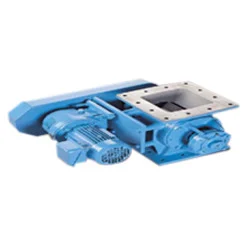Rotary Air Lock
A rotary airlock, also known as a rotary valve or rotary feeder, is a widely used device in industrial processes that involves the controlled flow of bulk materials between two different environments. It acts as a valve to regulate the discharge of granular or powdered materials from hoppers, silos, or other storage vessels while maintaining an airtight seal.
The primary function of a rotary airlock is to control the flow of material while preventing air leakage or loss of pressure. It consists of a cylindrical housing with a rotor inside that has vanes or blades. The rotor rotates continuously, creating a pocket or chamber between the vanes. As the material enters the airlock, it fills the pockets between the vanes while the rotor rotates. The rotation of the rotor then transports the material from the inlet side to the outlet side of the valve.

One of the crucial features of a rotary airlock is its ability to provide a reliable seal between different pressure zones. The vanes of the rotor, combined with the housing design, form a barrier that prevents air or gas from escaping or entering the system during material transfer. This airtight seal is vital in various industries, such as pneumatic conveying systems, dust collection systems, and bulk material handling, to maintain process efficiency and prevent contamination.
The size and construction of rotary airlocks vary depending on the application and the properties of the materials being handled. They can be made from various materials such as cast iron, stainless steel, or aluminum, depending on factors such as the abrasiveness or corrosiveness of the material. The rotor’s design, including the number and shape of the vanes, is also chosen based on the specific requirements of the process.
Rotary airlocks can be operated by various means, including electric motors, hydraulic systems, or pneumatic actuators. The speed and direction of rotation can be adjusted to control the material flow rate and ensure accurate dosing or metering. Some rotary airlocks also feature additional components such as speed sensors, level sensors, or pressure differentials to provide feedback and control the overall system.
Regular maintenance and inspection of rotary airlocks are essential to ensure their optimal performance and longevity. Wear and tear of the vanes, seals, or bearings can occur over time due to the abrasive nature of certain materials. Proper lubrication, cleaning, and replacement of worn parts are necessary to prevent operational issues and maintain efficient material flow.

